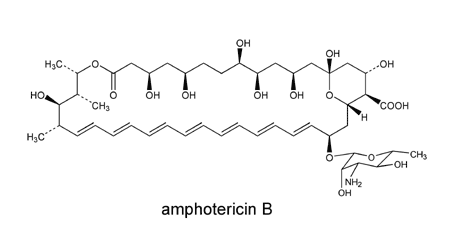Manufacturer’s Prescribing Information
Trade & Generic Names & General Features
Liposomal amphotericin B (L-AMB) is a lipid formulation of amphotericin B. As with the other lipid formulations, the major goal of developing L-AMB has been to attain a compound with lower toxicity and with at least similar efficacy compared to the parent compound, amphotericin B deoxycholate.
L-AMB is composed of amphotericin B complexed with hydrogenated soy phosphatidylcholine, distearoylphosphatidylglycerol, and cholesterol. Unlike the other lipid formulations of amphotericin B, it is a true liposome composed of unilamellar lipid vesicles [14, 1044]. L-AMB is being manufactured by Nexstar Pharmaceuticals (San Dimas, CA, USA). Its trade name is Ambisome™.
Compared to the other lipid formulations of amphotericin B, L-AMB reaches higher concentrations in plasma and remains in the circulation longer. Similar to the other lipid formulations, L-AMB concentrates in reticuloendothelial system. However, its uptake to the reticuloendothelial system cells is slower. This feature is presumably due to the smaller size, higher transition (melting) temperature and more rigid bilayer of the liposome. This finally provides a persistent pool of L-AMB in plasma and a sustained delivery to the site of infection [13, 1309, 1848, 2176]. L-AMB attains high concentrations in brain tissue [907].
Elimination of L-AMB from serum is biphasic. This pattern suggests that L-AMB is first concentrated in reticuloendothelial system cells and then is redistributed. [2356].

Mechanism(s) of Action
The mechanism of action and intrinsic antifungal activity of L-AMB is the same as the parent compound, amphotericin B [2232].
Susceptibility Patterns
The significance of susceptibility testing for L-AMB, as for that of any of the lipid formulations of amphotericin B, is not known. This is mainly due to the fact that the enhanced activity of lipid formulations of amphotericin B follows from the lesser toxicity of the lipid preparation. This permits administration of increased doses of amphotericin B and, presumably, increased delivery of active drug to sites of infection.
Comparative in vitro results have been reported. However, these results are inconsistent. Some investigators have observed similar in vitro activity for L-AMB and amphotericin B deoxycholate [65]. Others have reported higher L-AMB MICs against TO Candida spp. and Cryptococcus neoformans compared to amphotericin B deoxycholate and other lipid amphotericin B formulations [1129, 1705]. For Aspergillus spp., ranking of the in vitro activity of amphotericin B and its lipid formulations has been reported as amphotericin B deoxycholate = ABCD > L-AMB > ABLC [1668]. The relevance and meaning of these in vitro data remain yet unknown. In the interim, we believe that testing should simply be done with amphotericin B, the parent compound.
For susceptibility patterns of amphotericin B, amphotericin B. For L-AMB MICs obtained for various types of fungi, see susceptibility patterns and the N/A(L):susceptibility database.
Usual Doses
Optimal dose for L-AMB is not known. It is in general used at doses of 1-5 mg/kg [1044]. It has been reported that 1 mg/kg/day dosing is as effective as 4 mg/kg/day in treatment of invasive aspergillosis [666]. However, in this study, the number of patients with proven fungal infection is higher in the group receiving high-dose. Thus, the efficacy of high dose might have been low due to the existence of more definitive and serious infection. High dose application is still preferred by many authorities.
Side-Effects
Similar to the other lipid formulations, nephrotoxicity due to L-AMB is less frequent compared to amphotericin B deoxycholate [1542, 2372]. Other side effects are usually mild. Infusion related side effects [2372] and anaphylactic reactions [1284, 2245] have rarely been reported. Reversible hepatic dysfunction and hypernatremia have been observed [1542].
Routes
L-AMB is administered intravenously.
Current Status
L-AMB is used as a salvage agent when amphotericin B therapy fails or is unacceptably toxic. It is not a first-line drug for any of the fungal infections. It is also licensed as an empirical therapeutic agent in febrile neutropenia are [1844, 2357, 2372]. Its potency in different clinical settings is under continuing investigation. Among the lipid amphotericin B formulations, L-AMB is one of the more commonly used preparations.
